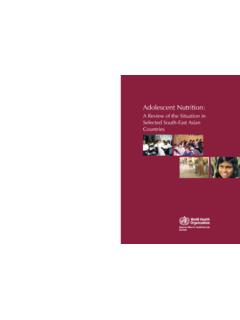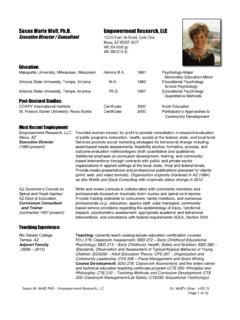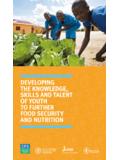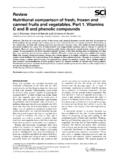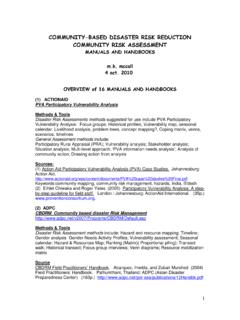Transcription of The key features of successful awareness raising campaigns
1 The key features of successful awareness raising campaigns Prepared by: Laura Masiulien . In co-operation with Janet Looney (EIESP). Hanne Aertgeerts (VUB). Maurice de Greef (VUB). This project has been funded with support from the European Commission. This publication reflects the views only of the author, and the Commission cannot be held responsible for any use which may be made of the information contained therein. 1. Table of Contents 1. Introduction .. 3. 2. Methodology .. 5. 3. What are the elements of a successful awareness raising campaign ? .. 6. Success factors of awareness raising campaigns in meta-reviews or evaluations in adult learning and in health .. 6. Success factors of awareness raising campaigns in adult learning. 6. Success factors of awareness raising in campaigns in health .. 9. 3. Conclusions and advice on factors for success .. 12. 2. 1. Introduction Low literacy1 remains one of the main challenges facing European society.
2 One in five European 15-year-olds and almost one in five adults lack the literacy skills needed to function successfully in a modern society2. Literacy is fundamental to human development, social and cultural participation, eradication of poverty, reduction of child mortality, achievement of gender equality and the development of strong democratic societies3. Low literacy skills increase the risk of poverty and social exclusion and limit numerous opportunities for cultural participation, lifelong learning and personal growth 4. In other words, sufficient literacy skills help people to live full and meaningful lives. The need to address the challenge of high rates of low literacy is now a key priority at the European level. Among the recent key European responses to the literacy challenges are the following: 1. Council Conclusions of 12 May 2009 on a strategic framework for European cooperation in education and training ( ET 2020 )5, which set the EU literacy target to have less than 15% low-achieving 15-year-olds in reading, mathematics and science by 20206.
3 2. The EU 2020 Strategy, which set ambitious objectives for smart, inclusive and sustainable growth for the entire European Union and emphasised that young people play an essential role in achieving this. Quality education and training, successful labour market integration and more mobility among young people are key in fully realising the EU's potential to achieve the Europe 2020 objectives. 3. The EU High Level Group of Experts on Literacy, which was established in 2011 by the European Commission, by invitation of the Council, examined strategies to support literacy through lifelong learning. The Group's work resulted in a ground-breaking report, in which literacy has been reviewed at EU level for the first time 7. The report set out proposals for improving literacy for youth and adults, and identifying common success factors in literacy programmes and policy initiatives. 4. The European Literacy Policy Network (ELINET) was established in 2014.
4 It is based on the work of the EU High Level Group of Experts and strives to improve literacy policies in all member countries, reduce the number of children, young people and adults with low literacy skills in Europe and to support the increase of reading skills and reading for pleasure 8. This report is part of the work of the ELINET network. The report aims to contribute to ELINET's objectives by providing evidence on success factors of awareness raising campaigns . Initially, the fundraising campaigns were also to be included in this report. However, in our literature we were not able to identify any evaluations of fundraising campaigns ; therefore the decision was made to focus only on awareness raising campaigns . 1. In this report understanding of literacy is in line with its definition provided on the ELINET webpage, literacy is a multi-layer concept, from baseline literacy to functional and multiple literacy (see more at: 2.)
5 EU High Level Group of Experts on Literacy 2012, Final Report. Luxembourg: European Commission. 3. Why literacy is important? Retrieved <4 March 2015>: ar/themes/learning-throughout-life/liter acy/literacy-important/. 4. EU High Level Group of Experts on Literacy 2012, Final Report. Luxembourg: European Commission. 5. European Council. Conclusions on a strategic framework for European cooperation in education and training ( ET 2020'), (2009/c 119/02). Official Journal of the European Union. 6. European Council. Conclusions on a strategic framework for European cooperation in education and training ( ET 2020'), (2009/c 119/02). Official Journal of the European Union. 7. EU High Level Group of Experts on Literacy 2012, Final Report. Luxembourg: European Commission. 8. ELINET Network (2014). Who we are. Retrieved <1 April 2015>: 3. awareness raising campaigns can be defined as organised communication activities which aim to create awareness on particular topics (health, environment, education), behavioural change among the general population and to improve the focus on better outcomes (better health, greater environmental protection, reduced early school leaving)9.
6 They often take the form of mass media campaigns10. Messages can be conveyed through many different channels, such as mass media (television, radio), social media, public relations, events, talks, demonstrations, tours and leaflets. awareness raising campaigns are recognised as the most efficient and effective means of communicating information especially to the general public11. Still, not all of them are effective in terms of influencing people's beliefs and changing their behaviour. Therefore, in order to establish and develop a successful awareness - raising campaign for low literacy in Europe, it is crucial to know the features of successful campaigns . This report contributes to deepening this knowledge by bringing together findings from meta- analyses on success factors of awareness raising campaigns in different fields, in particular in adult education and health. The current report is based on the desk research conducted by the ELINET team 8 for the report Indicators for evaluation of awareness and fundraising for low literacy in Europe: Research Review 12.
7 In line with the objectives outlined in the initial Call for a European Policy Network of National Literacy Organisations and defined activities, Team 8 earlier reviewed alternative methodologies to evaluate awareness - and fundraising campaign activities. The current report provides a further more in-depth analysis of meta-studies identified during the desk research conducted for the above mentioned report in order to identify and describe more detailed key success factors for awareness raising campaigns . 9. Hawkes, C. (2013). Promoting healthy diets through nutrition education and changes in the food environment: an international review of actions and their effectiveness. Retrieved <10 March 2015>. 10. Hawkes, C. (2013). Promoting healthy diets through nutrition education and changes in the food environment: an international review of actions and their effectiveness. Retrieved <10 March 2015>. 11. EIGE, Study on Collection of methods, tools and good practices in the field of domestic violence (area D of Beijing Platform for Action) , awareness raising .
8 Retrieved <2 April 2015>. 12. Ceneric, I., Looney, J., M., De Greef, M. (2014). Indicators for evaluation of awareness and fundraising for low literacy in Europe: Research Review. Cologne: ELINET. 4. 2. Methodology The sources for the current analysis were identified in an initial desk research phase and reported in Indicators for evaluation of awareness and fundraising for low literacy in Europe: Research review 13. This report described the methodologies and indicators used for evaluation of awareness raising and fundraising activities in a range of fields, such as financial literacy, psychology and health. During the desk research fifty-two relevant studies of awareness raising and fundraising campaigns were identified. Among them, 6 meta- evaluations and / or meta-reviews of various awareness raising campaigns in the fields of adult education and health were identified. All of them were evaluations of numerous awareness raising campaigns .
9 These sources were selected for further in-depth analysis: 1. EC. (2013). Strategies for improving participation in and awareness of adult learning: European Guide. Luxembourg, Publications Office of the European Union. 2. Robertson, R. (2008). Using information to promote healthy behaviours . King's Fund. 3. Cancer Care Research Centre, University of Stirling and Alliance for Self Care, University of Abertay (2006). A review of the effectiveness of interventions, approaches and models at individual, community and population level that are aimed at changing health outcomes through changing knowledge attitudes and behaviour. 4. Wakefield, M., Loken, B. Hornik (2010). Use of mass media campaigns to change health behaviour. Lancet 2010; 376: 1261 71. 5. Hawkes, C. (2013). Promoting healthy diets through nutrition education and changes in the food environment: an international review of actions and their effectiveness.
10 Rome: Nutrition Education and Consumer awareness Group, Food and Agriculture Organization of the United Nations. Retrieved <4 March 2015>, 6. Cavill N., Bauman A. (2007). Changing the way people think about health-enhancing physical activity: do mass media campaigns have a role? Journal of Sports Sciences, 22:8, 771-790. 13. Ceneric, I., Looney, J., M., De Greef, M. (2014). Indicators for evaluation of awareness and fundraising for low literacy in Europe: Research Review. Cologne: ELINET. 5. 3. What are the elements of a successful awareness raising campaign ? This chapter provides the overview of the features of successful awareness raising campaigns in meta-studies and meta-evaluations selected for analysis (see chapter 2). Firstly, the success factors of adult education campaigns are presented. Afterwards, the findings from meta-evaluations and / or meta-studies on awareness raising in health are described.
